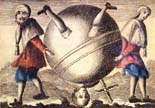Lies & Silences, or Fractures & Transformations – 1983

Current preoccupation with figuration and its surface treatment in painting have produced an amazing dearth of proper historical analysis. Curatorial pseudo-insights are once again the order of the day: and the artists once again have a market to produce for. All these fashionable rhapsodies have led to embarrassing omissions and liberal mystifications and obfuscations. If we are to make any critical approaches towards the understanding of current art practice then some attempt at historical clarification is a fundamental, initial requirement. Those practitioners who ignore and refuse such attempts, do so at their peril. Such perilous living may be profitable but not commendable.
In 1940 in his book Rabelais and His World (MIT Press, 1968, Trans. H Iswolsky) Mikhail Bakhtin, the Russian semiotician, outlines the notion of grotesque realism; this is useful in consideration of the ‘world turned upside down’, carnivalesque imagery that was prevalent in the middle ages with respect to the transformation of ecclesiastic imagery. The central principle of grotesque realism is degradation; that is, the lowering of everything that is high, the bringing down to a material, bodily element everything spiritual, ideal and abstract.
The bodily element, in terms of a social body, is opposed to the highly individualised bourgeois notions of the material, biological individual centred around the bourgeois ego. It is epitomised by the picture of people growing through the process of degradation and the consequent resurgence of life. Within grotesque realism the bodily functions become enlarged, exaggerated; this is the positive and assertive character of this form of realism. It is related strongly to the images of the natural world, to the images of birth, life, death, the sowing of seed, the fertility of the ground, and the growth of natural forms. These images are also of the human world, and therefore they are of the genital organs, the belly, the arse, etc. The imagery is topographically consonant with its ideas. Although its central point and manifestation is one of degradation, it is to be seen in a highly positive character. This degradation is not such that it simply brings down, but it brings down in order to produce a rebirth; therefore it brings down those things that it is important to destroy in order that this rebirth can occur. This transformational quality is central.
In the middle ages the carnival was used partially as a time for the letting off of steam. For one day, for one week, for one month, people could let the world turn upside down; they could be kings and queens for a short time. In doing this it acted as a safety valve and this mechanism allowed the hierarchies that were in power for the rest of the year to retain that power; this is the negative side of the carnival.
Carnival time was often a time of crisis. The outcome of this crisis depended upon the strength and nature of the powers that were involved. Le Roy Ladurie has pointed out in his book Carnival (Scolar Press, London, 1980, Trans. M Feeney) that in Romans in 1579- 80 reactionary elements gained power simply because of the possibility of sudden and effective action that carnival offered. The use of disguises was extremely important. They allowed the covering up of the identity of groups of people and therefore the possibility of distinguishing friend from foe in the chaos that ensued became very difficult. The disguise is instant pseudo self-transformation. If the disguise is removed the real individual is shown. In grotesque realism this can be turned upon its head so that the image of the real individual can be seen as a disguise and therefore potentially able to be taken off. In this way the self-transformational aspect of this occurrence can be seen more clearly; underneath this initial image appears the new person, the new group of people, the new society. In Walter Benjamin or Towards a Revolutionary Criticism (Verso, London, 1981) Terry Eagleton has pointed out that this self-transformatory notion is paralleled by that moment of revolutionary redemption that Walter Benjamin called Jetzeit. Benjamin’s notion of Jetzeit is one where the determinisms, either from an astrological or an historical point of view, are violently fractured by the carnivalesque rhetoric of liberation.
There are other ways in which Bakhtin’s ideas can be seen as related to Lukacs’ notion of critical realism (G Lukacs, The Meaning of Contemporary Realism, Merlin, London, 1963, Trans. J & H Mander); and he can be seen to be building in a positive fashion upon this in a similar way to that which Lukacs endeavoured to do in his elaboration of socialist realism. That Bakhtin is a materialist first and foremost is clear; his continuous attempt to bring everything back to the material level runs deeply through his discussion of Rabelias. Eagleton has also pointed out parallels between Bakhtin’s deconstruction and contemporary notions of deconstructivism. It is his historical materialism that distinguishes him however; for although the subject at the centre of Bakhtin’s carnivalesque imagery is in some ways deconstructed, taken apart, decentred; it is also filled up with the new materiality, filled up to excess, bursting with life. In this return to materiality, the imagery and the discourse return to materiality and they bring down to that level everything that pretends to be ‘other’, that is everything that is idealist.
If we consider the history of popular culture in the light of these notions we at least have some sort of starting point; we also have the possibility of understanding a way of producing a new attitude to discursive and art practice which entails the consideration and the centrality of self-transformational attitudes.
That materialism and inversion are central to any view of popular culture is in contradistinction to the centrality of idealism in high culture. This formulation is of course nothing new. In some forms it could be seen to merely reiterate the Platonic position with respect to the artist; that is, the artist is seen as somebody who is potentially dangerous, subversive of the ideal state. What is surprising, however , is the way in which it has been possible foe various societies to sustain forced ignorance of this formulation of the two streams of culture. One seems to have thrust its way in to such a point that the other is hardly considerable at all. Those who hold the greatest power will sustain their own high culture to the exclusion of popular culture(s). It is only recently that this position has started to be reversed. The function of high-art images is most easily seen in the Christian tradition; the use of images can be seen as essentially Aristotelian, or at least Thomist. The binding together of an epistemology, a theology and a theory of art, is the structure that is at the heart of European high art. Art is seen a revelatory, it is seen a revealing the hierarchies of the status quo. It is against this view of art that the position of grotesque realism must be set.
Its oppositional quality is clear. However what might be seen as problematic is its seeming dependence for its own continuance upon its antithetical nature with respect to this vast idealistic superstructure. It only becomes less problematic once it is understood that its transformational qualities are based around the continuing reaction to the circumstances within which people find themselves and the contradictions that are held within their own lives. Contradictions in people’s lives are not going to disappear, although the nature and the site of these contradictions may change. It is in this sense that it is a realism; it is based upon real contradictions. These contradictions are made apparent by a social dynamic of s distinctly non-historic, non-determinist kind. A well sorted teleology is not available. A set, or sets of sets of strategies for the social dynamic, however, is. The possibility of social change is fundamental to the notion of popular culture and carnival clears the ground for this to occur. In the light of this iconoclastic nature can be understood. the nature of relationships and the gaps between epistemic breaks, material transformations or revolutions, paradigm shifts and fractures in discursive and visual practice are extremely complex and unclear. This lack of clarity most obvious in the case of carnival where there is a discursive and visual practice which is fractured and there is also the possibility of a material fracture. Carnival is both a representation of the world and of the world itself; therefore the fractures that it either represents or creates are interwoven and inseparable. Its imagery and practice are so bound up with material bodily functions that there is no possibility of the imagery being seen in an autonomous light separated from the practices of the social section involved. Indeed it allows a certain autonomy of this social section by its very practice. As discursive and visual practice and its products become separated so the products become increasingly iconic. This increasing iconicity parallels a decreasing power for social change. The icon is a product of and produces social determinism; iconoclasm produces and is a product of social transformation. Iconicity is a facet of the socialisation of idealism, iconoclasm is the material fracturing of iconicity. However there is no possibility of a simple resolution of the nature of the causal relationships between these different fractures and transformations. The study of particular historical examples can elaborate the nature of previous fractures and transformations and open the way to a production of a more general theory of the production of fractures and transformations. This historical study entails the historical study of popular culture. Popular culture is not to be seen as a simple string of fractures and transformations, but it is the complex made up of such strings and the stringing together of the gaps between fractures and transformations and the attempts at fractures and transformations. This complexity and its resonances within current art practice must be understood and careful critical consideration must wrest the significant from the lies and silences of the fashionable rhapsodist.
Graham Howard, 1983
From the “Dirty Tricks” catalogue of 1984, this text is an extract from an article on Grotesque Realism by Graham Howard.
